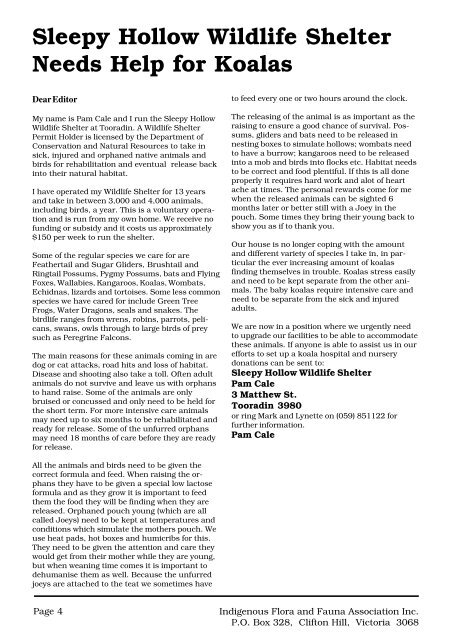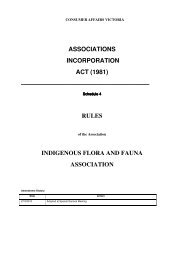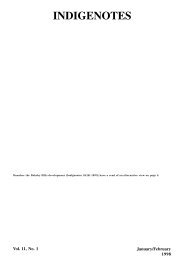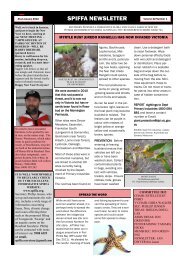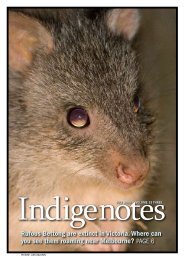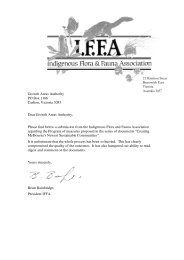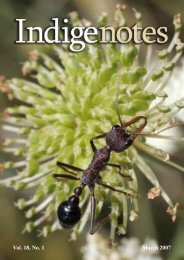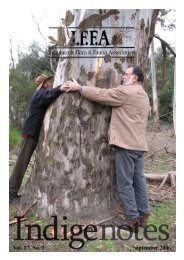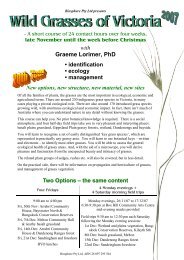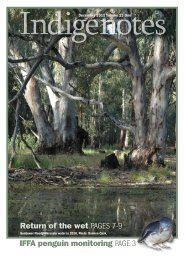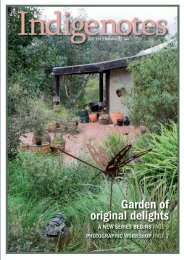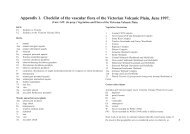8-8 August 1995 - Indigenous Flora and Fauna Association
8-8 August 1995 - Indigenous Flora and Fauna Association
8-8 August 1995 - Indigenous Flora and Fauna Association
You also want an ePaper? Increase the reach of your titles
YUMPU automatically turns print PDFs into web optimized ePapers that Google loves.
Sleepy Hollow Wildlife Shelter<br />
Needs Help for Koalas<br />
Dear Editor<br />
My name is Pam Cale <strong>and</strong> I run the Sleepy Hollow<br />
Wildlife Shelter at Tooradin. A Wildlife Shelter<br />
Permit Holder is licensed by the Department of<br />
Conservation <strong>and</strong> Natural Resources to take in<br />
sick, injured <strong>and</strong> orphaned native animals <strong>and</strong><br />
birds for rehabilitation <strong>and</strong> eventual release back<br />
into their natural habitat.<br />
I have operated my Wildlife Shelter for 13 years<br />
<strong>and</strong> take in between 3,000 <strong>and</strong> 4,000 animals,<br />
including birds, a year. This is a voluntary operation<br />
<strong>and</strong> is run from my own home. We receive no<br />
funding or subsidy <strong>and</strong> it costs us approximately<br />
$150 per week to run the shelter.<br />
Some of the regular species we care for are<br />
Feathertail <strong>and</strong> Sugar Gliders, Brushtail <strong>and</strong><br />
Ringtail Possums, Pygmy Possums, bats <strong>and</strong> Flying<br />
Foxes, Wallabies, Kangaroos, Koalas, Wombats,<br />
Echidnas, lizards <strong>and</strong> tortoises. Some less common<br />
species we have cared for include Green Tree<br />
Frogs, Water Dragons, seals <strong>and</strong> snakes. The<br />
birdlife ranges from wrens, robins, parrots, pelicans,<br />
swans, owls through to large birds of prey<br />
such as Peregrine Falcons.<br />
The main reasons for these animals coming in are<br />
dog or cat attacks, road hits <strong>and</strong> loss of habitat.<br />
Disease <strong>and</strong> shooting also take a toll. Often adult<br />
animals do not survive <strong>and</strong> leave us with orphans<br />
to h<strong>and</strong> raise. Some of the animals are only<br />
bruised or concussed <strong>and</strong> only need to be held for<br />
the short term. For more intensive care animals<br />
may need up to six months to be rehabilitated <strong>and</strong><br />
ready for release. Some of the unfurred orphans<br />
may need 18 months of care before they are ready<br />
for release.<br />
to feed every one or two hours around the clock.<br />
The releasing of the animal is as important as the<br />
raising to ensure a good chance of survival. Possums,<br />
gliders <strong>and</strong> bats need to be released in<br />
nesting boxes to simulate hollows; wombats need<br />
to have a burrow; kangaroos need to be released<br />
into a mob <strong>and</strong> birds into flocks etc. Habitat needs<br />
to be correct <strong>and</strong> food plentiful. If this is all done<br />
properly it requires hard work <strong>and</strong> alot of heart<br />
ache at times. The personal rewards come for me<br />
when the released animals can be sighted 6<br />
months later or better still with a Joey in the<br />
pouch. Some times they bring their young back to<br />
show you as if to thank you.<br />
Our house is no longer coping with the amount<br />
<strong>and</strong> different variety of species I take in, in particular<br />
the ever increasing amount of koalas<br />
finding themselves in trouble. Koalas stress easily<br />
<strong>and</strong> need to be kept separate from the other animals.<br />
The baby koalas require intensive care <strong>and</strong><br />
need to be separate from the sick <strong>and</strong> injured<br />
adults.<br />
We are now in a position where we urgently need<br />
to upgrade our facilities to be able to accommodate<br />
these animals. If anyone is able to assist us in our<br />
efforts to set up a koala hospital <strong>and</strong> nursery<br />
donations can be sent to:<br />
Sleepy Hollow Wildlife Shelter<br />
Pam Cale<br />
3 Matthew St.<br />
Tooradin 3980<br />
or ring Mark <strong>and</strong> Lynette on (059) 851122 for<br />
further information.<br />
Pam Cale<br />
All the animals <strong>and</strong> birds need to be given the<br />
correct formula <strong>and</strong> feed. When raising the orphans<br />
they have to be given a special low lactose<br />
formula <strong>and</strong> as they grow it is important to feed<br />
them the food they will be finding when they are<br />
released. Orphaned pouch young (which are all<br />
called Joeys) need to be kept at temperatures <strong>and</strong><br />
conditions which simulate the mothers pouch. We<br />
use heat pads, hot boxes <strong>and</strong> humicribs for this.<br />
They need to be given the attention <strong>and</strong> care they<br />
would get from their mother while they are young,<br />
but when weaning time comes it is important to<br />
dehumanise them as well. Because the unfurred<br />
joeys are attached to the teat we sometimes have<br />
Page 4<br />
<strong>Indigenous</strong> <strong>Flora</strong> <strong>and</strong> <strong>Fauna</strong> <strong>Association</strong> Inc.<br />
P.O. Box 328, Clifton Hill, Victoria 3068


